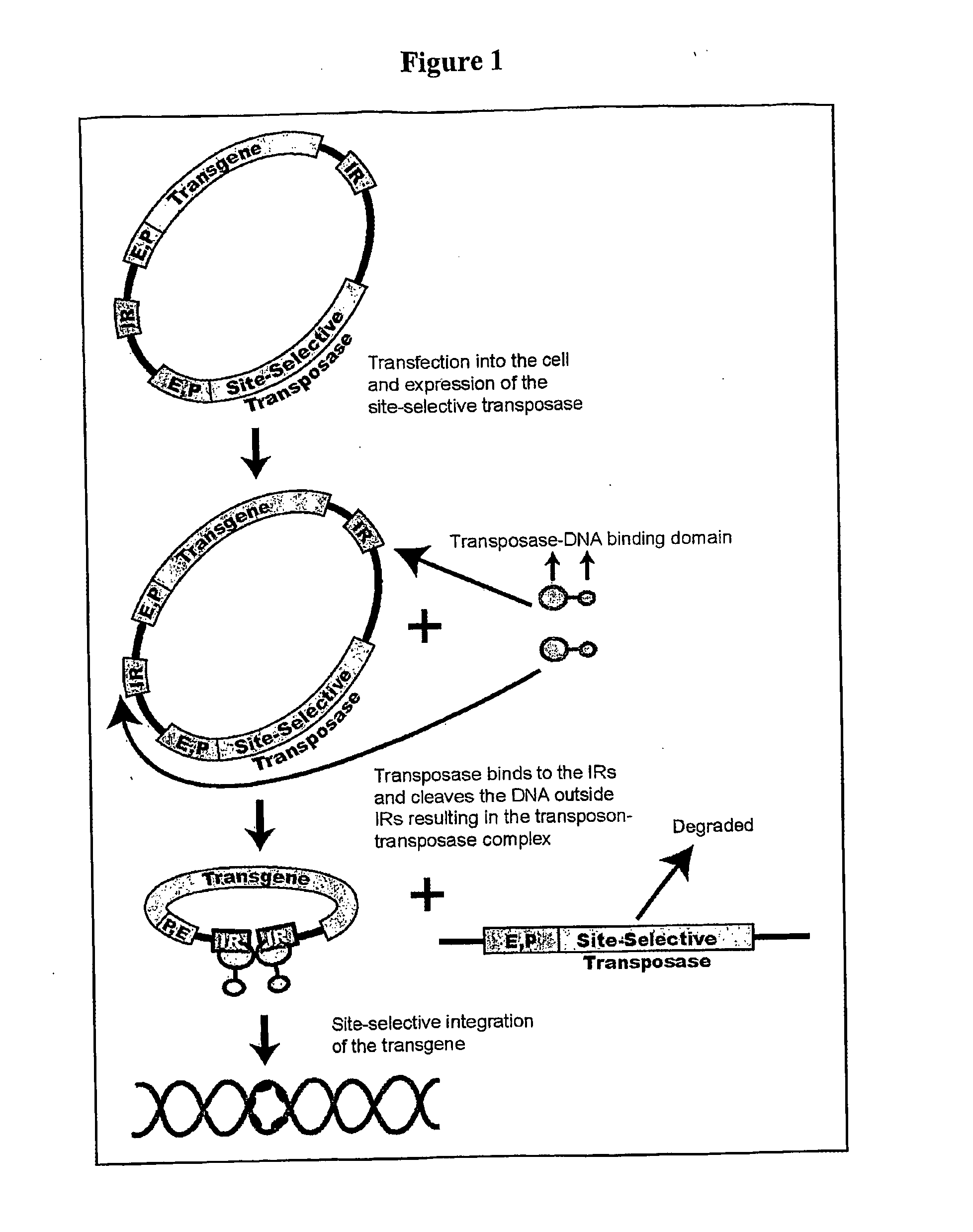Transposon-based vectors and methods of nucleic acid integration
a technology of nucleic acid integration and transposon, applied in the direction of enzymology, viruses/bacteriophages, enzymology, etc., can solve the problems of limiting the use of viral based systems, life-threatening systemic effects, and limiting the efficacy of gene-transfer
- Summary
- Abstract
- Description
- Claims
- Application Information
AI Technical Summary
Problems solved by technology
Method used
Image
Examples
example 1
1. Example 1
[0272] a) Preparation of Nucleic Acid Constructs Encoding Invention Chimeric Proteins
[0273] Chimeric transposases [e.g. Tc1 (Reference No. NM—061407, AI878683, AI878522, AI794017); P-element (Rio et al., Cell (1986) 44:21-32; among others)] containing the DNA-binding domain at the “amino-terminal” or “carboxyl-terminal” are constructed using fusion PCR (see, e.g., Vallette, et al., 1989, NAR, 17:723-733; and Yon and Fried, 1989, NAR, 17:4895). The transposase coding region constructed as described and the DNA binding domain (e.g., zif268 coding region) constructed as described are separately amplified by PCR. Primers are designed employing well-known methods to contain a region of overlap that encodes the desired fusion junction. PCR products from the two separate reactions are then purified, mixed, and subjected to a second PCR reaction using primers directed at either side of the overlap region. In the first cycle of the second round, strands from the two reaction pro...
example 2
2. Example 2
[0278] Chimeric transposases are provided comprising known transposases (e.g., Sleeping Beauty, Tn7, Tn916, Tc1 / mariner, Tc3, maT, and others listed herein) containing the lexA DNA binding domain (DBD) fused precisely at the N— or C-termini. Examples of known non-chimeric transposases can be found throughout the literature and are incorporated by reference herein from the following: Sleeping Beauty (Izsvak Z, Ivics Z, and Plasterk R H. (2000) Sleeping Beauty, a wide host-range transposon vector for genetic transformation in vertebrates. J. Mol. Biol. 302:93-102), Tn5 (Bhasin A, et al. (2000) Characterization of a Tn5 pre-cleavage synaptic complex. J Mol Biol 302:49-63), Tn7 (Kuduvalli P N, Rao J E, Craig N L. (2001) Target DNA structure plays a critical role in Tn7 transposition. EMBO J 20:924932), Tn916 (Marra D, Scott JR. (1999) Regulation of excision of the conjugative tranposon Tn916. Mol Microbiol 2:609-621), Tc1 / mariner (Izsvak Z, Ivics Z, Hackett P B. (1995) Chara...
example 3
3. Example 3
Targeted Transposition of the maT Transposon
[0282] a) Assessing Targeted Integration of maT in Insect Cells.
[0283] maT is a member of the Tc1 / mariner superfamily of transposons. Characteristic of mariner-like elements, maT has a DDD catalytic triad. The ITRs of maT more closely resemble those of Tc1 than mariner and structural indications show the N-terminal domain to be unique from either mariner or Tc1. Additionally the DNA binding domain more closely resembles Pax / paired transcription factors and Tc3 transposase than the Tc1 / mariner transposases.
[0284] The ability of a modified, chimeric maT transposase to promote transposon integration to either Ga14 or LexA binding sites is assessed. Insect cell lines and insect embryos are transfected with two to three plasmids. The first plasmid, referred to as the donor plasmid, contains a modified maT transposon that has its inverted terminal repeats and transposase binding domains intact, but its transposase gene has been re...
PUM
| Property | Measurement | Unit |
|---|---|---|
| Nuclear radiation | aaaaa | aaaaa |
Abstract
Description
Claims
Application Information
 Login to View More
Login to View More - R&D
- Intellectual Property
- Life Sciences
- Materials
- Tech Scout
- Unparalleled Data Quality
- Higher Quality Content
- 60% Fewer Hallucinations
Browse by: Latest US Patents, China's latest patents, Technical Efficacy Thesaurus, Application Domain, Technology Topic, Popular Technical Reports.
© 2025 PatSnap. All rights reserved.Legal|Privacy policy|Modern Slavery Act Transparency Statement|Sitemap|About US| Contact US: help@patsnap.com



